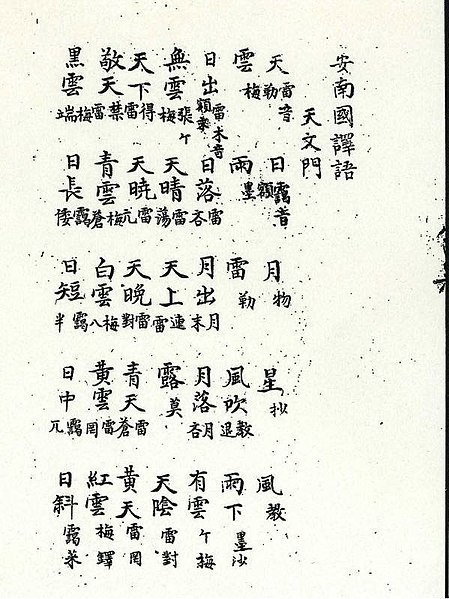Chữ Nôm is a logographic writing system formerly used to write the Vietnamese language. It uses Chinese characters to represent Sino-Vietnamese vocabulary and some native Vietnamese words, with other words represented by new characters created using a variety of methods, including phono-semantic compounds. This composite script was therefore highly complex and was accessible to less than five percent of the Vietnamese population who had mastered written Chinese.
A page from Tự Đức thánh chế tự học giải nghĩa ca (嗣德聖製字學解義歌), a 19th-century primer for teaching Vietnamese children Chinese characters. The work is attributed to Emperor Tự Đức, the fourth emperor of the Nguyễn dynasty. In this primer, chữ Nôm is used to gloss the Chinese characters, for example, 𡗶 is used to gloss 天.
A page from the bilingual dictionary Nhật dụng thường đàm (日用常談; 1851). Characters representing words in Hán (Chinese) are explained in Nôm (Vietnamese).
A page from The Tale of Kieu by Nguyễn Du. This novel was first published in 1820 and is the best-known work in Nôm. The edition shown was printed in the late 19th century.
The second page of Tam tự kinh lục bát diễn âm (三字經六八演音) with the original Literary Chinese text on the top, and Vietnamese translation on the bottom. The Vietnamese text is written in chữ Nôm and lục bát (六八) verse form.
Vietnamese is an Austroasiatic language spoken primarily in Vietnam where it is the national and official language. Vietnamese is spoken natively by around 85 million people,
several times as many as the rest of the Austroasiatic family combined. It is the native language of the Vietnamese (Kinh) people, as well as a second or first language for other ethnic groups in Vietnam.
An Nam quốc dịch ngữ 安南國譯語 recorded the pronunciations of 15th century Vietnamese, such as for 天 (sky) - 雷 /luei/ representing blời (Modern Vietnamese: trời).
In the bilingual dictionary Nhật dụng thường đàm (1851), Chinese characters (chữ Nho) are explained in chữ Nôm.
Jean-Louis Taberd's dictionary Dictionarium anamitico-latinum (1838) represents Vietnamese (then Annamese) words in the Latin alphabet and chữ Nôm.
A sign at the Hỏa Lò Prison museum in Hanoi lists rules for visitors in both Vietnamese and English.







